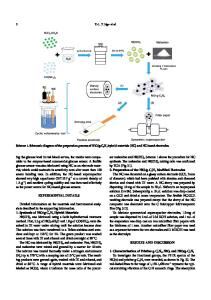NASICON-Structured NaTi 2 (PO 4 ) 3 for Sustainable Energy Storage
- PDF / 5,351,473 Bytes
- 36 Pages / 595.276 x 790.866 pts Page_size
- 54 Downloads / 211 Views
REVIEW
Cite as Nano-Micro Lett. (2019) 11:44 Received: 13 March 2019 Accepted: 23 April 2019 © The Author(s) 2019
https://doi.org/10.1007/s40820-019-0273-1
NASICON‑Structured NaTi2(PO4)3 for Sustainable Energy Storage Mingguang Wu1, Wei Ni2,3 *, Jin Hu1 *, Jianmin Ma1,4 * * Wei Ni, [email protected]; Jin Hu, [email protected]; Jianmin Ma, [email protected] School of Physics and Electronics, Hunan University, Changsha 410082, People’s Republic of China 2 Faculty of Technology, University of Oulu, 90014 Oulu, Finland 3 Panzhihua University, Panzhihua 617000, People’s Republic of China 4 Key Laboratory of Materials Processing and Mold, Ministry of Education, Zhengzhou University, Zhengzhou 450002, People’s Republic of China 1
HIGHLIGHTS • For the first time, we fully presented the recent progress of the application of NaTi2(PO4)3 on sodium-ion batteries including nonaqueous batteries, aqueous batteries, aqueous batteries with desalination, and sodium-ion hybrid capacitors. • The unique NASICON structure of NaTi2(PO4)3 and the various strategies on improving the performance of NaTi2(PO4)3 electrode have been presented and summarized in detail.
ABSTRACT Several emerging energy storage technologies and systems have been
demonstrated that feature low cost, high rate capability, and durability for potential use in large-scale grid and high-power applications. Owing to its outstanding ion conductivity, ultrafast Na-ion insertion kinetics, excellent structural stability, and large theoretical capacity, the sodium superionic conductor (NASICON)-structured insertion material N aTi2(PO4)3 (NTP) has attracted considerable attention as the optimal electrode material for sodium-ion batteries (SIBs) and Na-ion hybrid capacitors
(NHCs). On the basis of recent studies, NaTi2(PO4)3 has raised the rate capabilities,
cycling stability, and mass loading of rechargeable SIBs and NHCs to commercially
acceptable levels. In this comprehensive review, starting with the structures and electrochemical properties of NTP, we present recent progress in the application of NTP to SIBs, including non-aqueous batteries, aqueous batteries, aqueous batteries with desalination, and sodium-ion hybrid capacitors. After a thorough discussion of the unique NASICON structure of NTP, various strategies for improving the performance of NTP electrode have been presented and summarized in detail. Further, the major challenges and perspectives regarding the prospects for the use of NTP-based electrodes in energy storage systems have also been summarized to offer a guideline for further improving the performance of NTP-based electrodes. KEYWORDS NaTi2(PO4)3; Sodium superionic conductor; Anode; Batteries; Hybrid capacitors
Vol.:(0123456789)
13
44
Page 2 of 36
1 Introduction In recent years, with the increasing consumption of fossil fuels, numerous studies have investigated the development of various types of renewable and clean energy devices [1–10]. Among current technologies, lithium-ion batteries (LIBs) have been considerably developed a
Data Loading...










